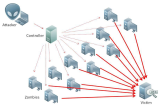
German industrial production exceeded expectations in February, providing some relief from fears of a recession in the country. The Federal Statistical Office reported
that factory output increased by 2.0% in February, compared to 3.7% in January, surpassing economists' estimates of a slight rise of 0.1%. On a year-on-year basis, the figure inched up by 0.6%. The majority of Germany's economic sectors saw an increase in their production levels in February, with the automotive industry, in particular, experiencing a rise in output of 7.6% month-on-month. Production in energy-intensive industries also rose by 1.9%, although it remains down by 12% year-on-year.
According to analysts at ING, "German industry seems to have woken up from hibernation," and the strong rebound appears to be driven by the reopening of China, strong activity in the automotive sector, and a more general ongoing reduction of backlogs. They added that the industrial data helps remove the risk of Germany slipping into a technical recession, which is defined as two consecutive quarters of economic contraction.
The industrial production data follows a prediction by leading economic institutes in Germany on Wednesday that price-adjusted gross domestic product (GDP) would edge up by 0.3% in 2023, as easing supply bottlenecks and cheaper energy prices boost the country's all-important manufacturing sector. The previous projection was for an annual decline in economic growth of -0.4%.
However, the ING analysts remain cautious about the outlook for Germany, noting the potential knock-on effects of a possible slowdown in the U.S. economy. They warned that it would not be the first time that the German (and the European) economy starts the year on a positive note, only to lose momentum over the course of the year.
The German economy has been facing a challenging time due to a combination of factors such as the pandemic, supply chain disruptions, and energy prices. The country's GDP shrank by 0.5% in the fourth quarter of 2022, the first decline in four years. The drop was mainly attributed to supply chain disruptions and a decline in exports due to rising energy prices. The European Central Bank's decision to reduce its asset purchases has also raised concerns about the economic recovery in the eurozone.
The recent industrial production data is a positive sign for the German economy, as it indicates that the country's manufacturing sector is recovering. This is particularly important as the manufacturing sector is the backbone of the German economy, accounting for around 20% of the country's GDP and employing around 10 million people.
In conclusion, the German industrial production data for February exceeded expectations, providing some hope that the country's manufacturing sector is recovering. However, the ING analysts cautioned that the outlook for Germany remains uncertain, and the potential knock-on effects of a possible slowdown in the U.S. economy could still impact the country's economic recovery. Photo by Norbert Nagel, Wikimedia commons.








































